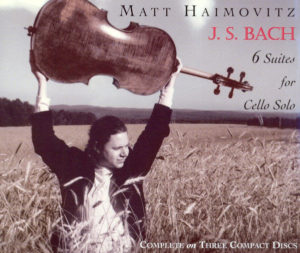
Matt Haimovitz. Bach Cello Suites CD Oxingale Records OX 2000.
Released 2000. Recorded at the Plainfield congregational Church Massachusetts. July 10-13 August 6-7 2000.
Matt Haimovitz plays a Matteo Gofriller from 1710 with modern set up.
Introduction.
This is the first of two recordings of the Suites by this artist. It is also the first release on a label he and his wife Luna Pearl Woolf set up. Luna is also credited with production.
Apparently, the name of the label comes from a quote by Voltaire: “Sir, you make me believe in miracles; you know how to turn an ox into a nightingale”.
This release consists of a 3CD box set which allows the sequential listening of the Suites and panders to the more fussy CD player (mine included) which struggle with 76min + CDs. Of interest is that this CD release is a HDCD release, again of benefit if you have a CD player compatible with this format such as NAIM products.
The Cellist
Matt was born in Israel but moved to the United States as a child where his most well-known teacher was Leonard Rose. He appears to have risen to international fame rapidly before he was 20. Repeated quotes of reviews are of his “uncommon expressive gifts” and “Megawatt sound”. After a number of years pursuing a conventional classical soloist career, he appears to have branched out into a number of different genres including popular music and modern classical/jazz. He has recorded several cello pieces by Philip Glass and performed at the CBGB club infamous in the punk era. More recently he appears to be involved with teaching at the McGill university in Canada. This link to an interview fills in some gaps.
http://www.cello.org/Newsletter/Articles/haimovitz/haimovitz.htm
The Recording.
The good news is that this is a great sounding recording, with full tone, broad soundstage, and great dynamics. The tone of the Gofriller is well captured. There is not too much echo and no extraneous noises from the artist impacting on this listener.
The Music.
The not so good news is that this is a very idiosyncratic rendition which I suspect is pretty much what the reviewer quoted as saying “uncommon expressive gifts” meant!
I can summarise by saying that the dynamics, variation in speed and differing voices used are more than any other recording I have heard. Furthermore, these variations occur frequently, often several times in a single bar.
It is very clear that Haimovitz possesses technical skills far more than many soloists. His facility, tuning and expressiveness are in no doubt. What I do have reservations about are the merits of the finished performance.
For me (and it is hugely subjective) the result is a performance which impresses but does not inspire or penetrate my innermost feelings. The fluidity and flow are disrupted by constant change of phrasing, speed, and dynamics.
I do wonder if this performer’s abilities are so great that he has struggled to find challenges in his chosen arena and is therefore seeking new and unorthodox ways of finding that stimulus to his further development.
There are likely many who do appreciate the qualities displayed but this is not one for me. If you want to check out what I mean, have a listen to the fourth Suite particularly the Bourrées on a streaming service. Also listen to the sixth Gigue. For me, if there had not been such unexpected tempo changes, this last movement would have been outstanding. Another interesting touch is to repeat the Minuet I of the second Suite pizzicato. I have heard this done with the fifth Sarabande before.
Conclusion.
In summary, a Marmite version! This style of playing will be exciting and stimulating in a live performance, but on a recording, for me, the quirks on repeat listening would start to grate.
Charles.